
1Confidential and proprietary information. © 2025 Sallie Mae Bank. All rights reserved. Investor Presentation 3rd Quarter 2025
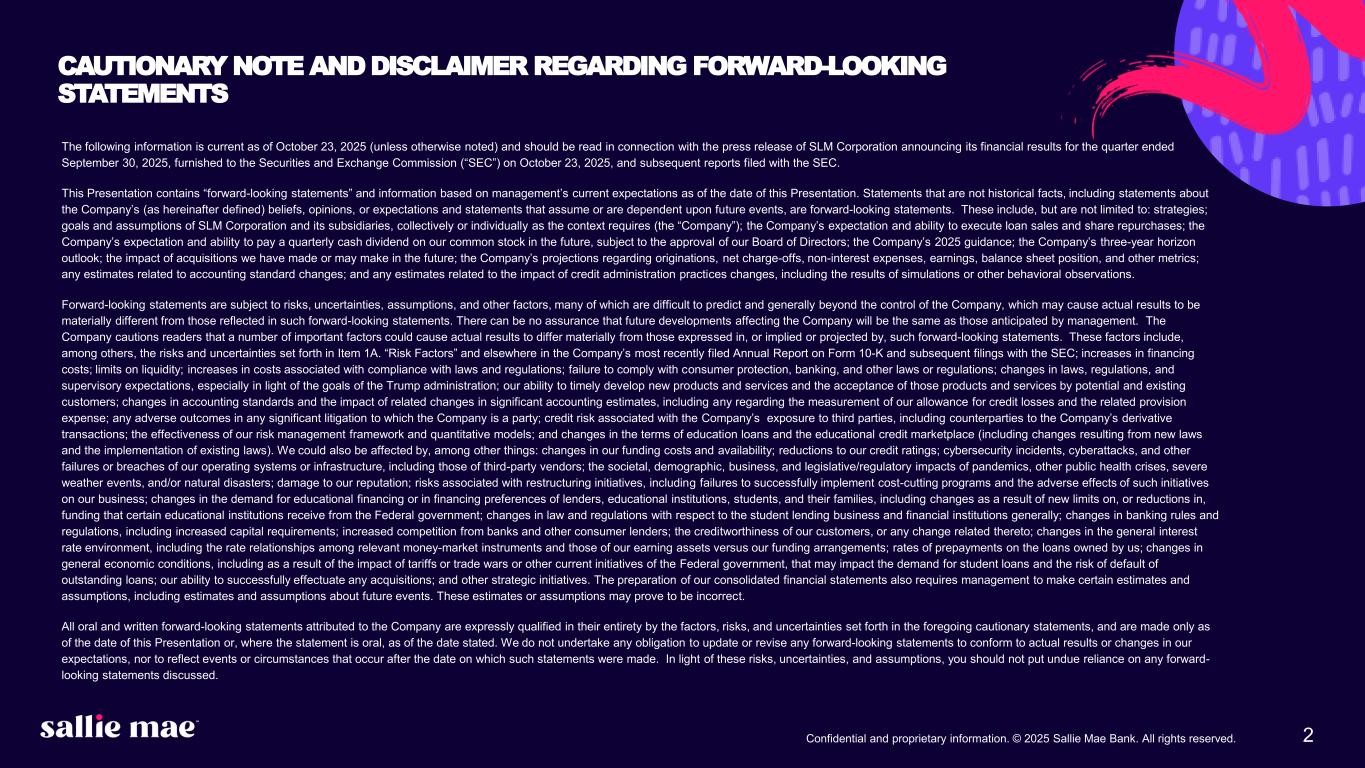
2Confidential and proprietary information. © 2025 Sallie Mae Bank. All rights reserved. The following information is current as of October 23, 2025 (unless otherwise noted) and should be read in connection with the press release of SLM Corporation announcing its financial results for the quarter ended September 30, 2025, furnished to the Securities and Exchange Commission (“SEC”) on October 23, 2025, and subsequent reports filed with the SEC. This Presentation contains “forward-looking statements” and information based on management’s current expectations as of the date of this Presentation. Statements that are not historical facts, including statements about the Company’s (as hereinafter defined) beliefs, opinions, or expectations and statements that assume or are dependent upon future events, are forward-looking statements. These include, but are not limited to: strategies; goals and assumptions of SLM Corporation and its subsidiaries, collectively or individually as the context requires (the “Company”); the Company’s expectation and ability to execute loan sales and share repurchases; the Company’s expectation and ability to pay a quarterly cash dividend on our common stock in the future, subject to the approval of our Board of Directors; the Company’s 2025 guidance; the Company’s three-year horizon outlook; the impact of acquisitions we have made or may make in the future; the Company’s projections regarding originations, net charge-offs, non-interest expenses, earnings, balance sheet position, and other metrics; any estimates related to accounting standard changes; and any estimates related to the impact of credit administration practices changes, including the results of simulations or other behavioral observations. Forward-looking statements are subject to risks, uncertainties, assumptions, and other factors, many of which are difficult to predict and generally beyond the control of the Company, which may cause actual results to be materially different from those reflected in such forward-looking statements. There can be no assurance that future developments affecting the Company will be the same as those anticipated by management. The Company cautions readers that a number of important factors could cause actual results to differ materially from those expressed in, or implied or projected by, such forward-looking statements. These factors include, among others, the risks and uncertainties set forth in Item 1A. “Risk Factors” and elsewhere in the Company’s most recently filed Annual Report on Form 10-K and subsequent filings with the SEC; increases in financing costs; limits on liquidity; increases in costs associated with compliance with laws and regulations; failure to comply with consumer protection, banking, and other laws or regulations; changes in laws, regulations, and supervisory expectations, especially in light of the goals of the Trump administration; our ability to timely develop new products and services and the acceptance of those products and services by potential and existing customers; changes in accounting standards and the impact of related changes in significant accounting estimates, including any regarding the measurement of our allowance for credit losses and the related provision expense; any adverse outcomes in any significant litigation to which the Company is a party; credit risk associated with the Company’s exposure to third parties, including counterparties to the Company’s derivative transactions; the effectiveness of our risk management framework and quantitative models; and changes in the terms of education loans and the educational credit marketplace (including changes resulting from new laws and the implementation of existing laws). We could also be affected by, among other things: changes in our funding costs and availability; reductions to our credit ratings; cybersecurity incidents, cyberattacks, and other failures or breaches of our operating systems or infrastructure, including those of third-party vendors; the societal, demographic, business, and legislative/regulatory impacts of pandemics, other public health crises, severe weather events, and/or natural disasters; damage to our reputation; risks associated with restructuring initiatives, including failures to successfully implement cost-cutting programs and the adverse effects of such initiatives on our business; changes in the demand for educational financing or in financing preferences of lenders, educational institutions, students, and their families, including changes as a result of new limits on, or reductions in, funding that certain educational institutions receive from the Federal government; changes in law and regulations with respect to the student lending business and financial institutions generally; changes in banking rules and regulations, including increased capital requirements; increased competition from banks and other consumer lenders; the creditworthiness of our customers, or any change related thereto; changes in the general interest rate environment, including the rate relationships among relevant money-market instruments and those of our earning assets versus our funding arrangements; rates of prepayments on the loans owned by us; changes in general economic conditions, including as a result of the impact of tariffs or trade wars or other current initiatives of the Federal government, that may impact the demand for student loans and the risk of default of outstanding loans; our ability to successfully effectuate any acquisitions; and other strategic initiatives. The preparation of our consolidated financial statements also requires management to make certain estimates and assumptions, including estimates and assumptions about future events. These estimates or assumptions may prove to be incorrect. All oral and written forward-looking statements attributed to the Company are expressly qualified in their entirety by the factors, risks, and uncertainties set forth in the foregoing cautionary statements, and are made only as of the date of this Presentation or, where the statement is oral, as of the date stated. We do not undertake any obligation to update or revise any forward-looking statements to conform to actual results or changes in our expectations, nor to reflect events or circumstances that occur after the date on which such statements were made. In light of these risks, uncertainties, and assumptions, you should not put undue reliance on any forward- looking statements discussed. CAUTIONARY NOTE AND DISCLAIMER REGARDING FORWARD-LOOKING STATEMENTS
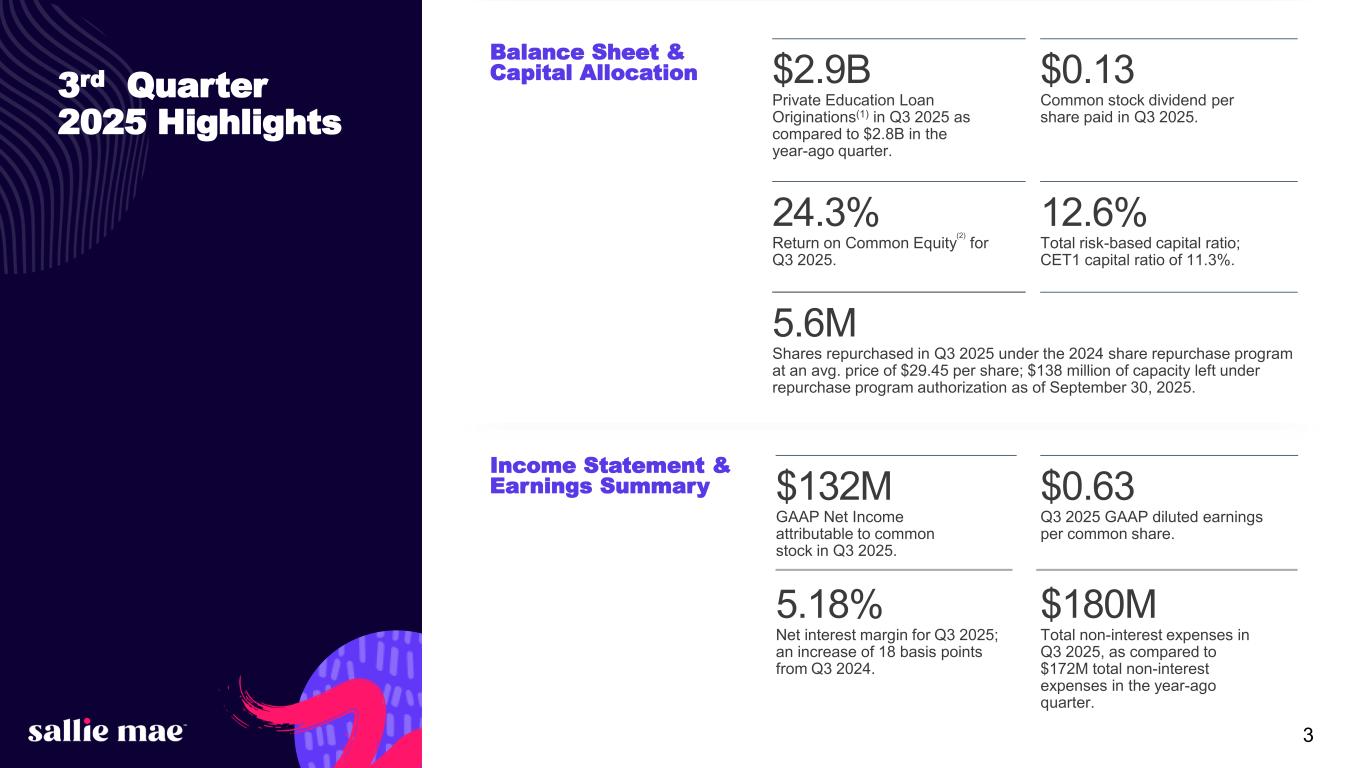
3 $132M GAAP Net Income attributable to common stock in Q3 2025. $0.63 Q3 2025 GAAP diluted earnings per common share. 5.18% Net interest margin for Q3 2025; an increase of 18 basis points from Q3 2024. $180M Total non-interest expenses in Q3 2025, as compared to $172M total non-interest expenses in the year-ago quarter. 3rd Quarter 2025 Highlights $2.9B Private Education Loan Originations(1) in Q3 2025 as compared to $2.8B in the year-ago quarter. $0.13 Common stock dividend per share paid in Q3 2025. 24.3% Return on Common Equity (2) for Q3 2025. 12.6% Total risk-based capital ratio; CET1 capital ratio of 11.3%. 5.6M Shares repurchased in Q3 2025 under the 2024 share repurchase program at an avg. price of $29.45 per share; $138 million of capacity left under repurchase program authorization as of September 30, 2025. Balance Sheet & Capital Allocation Income Statement & Earnings Summary
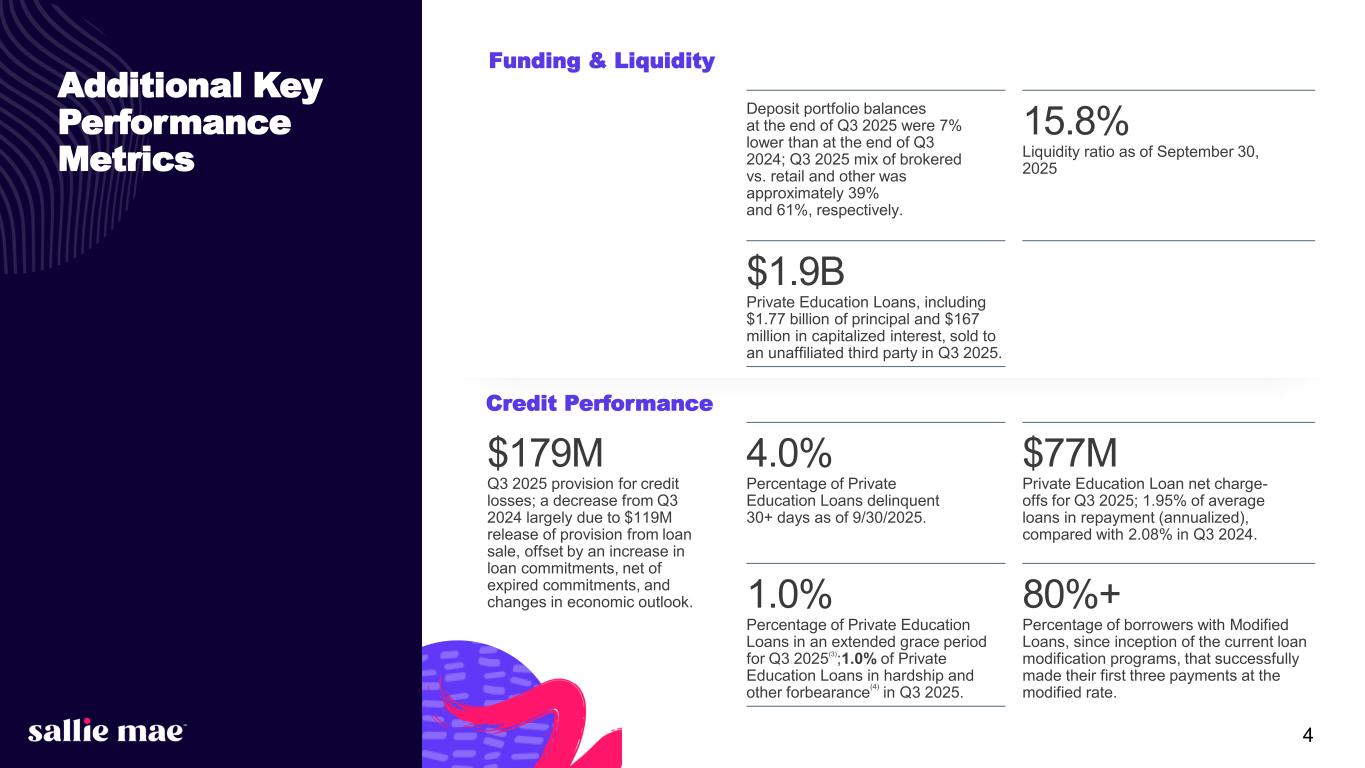
4 $179M Q3 2025 provision for credit losses; a decrease from Q3 2024 largely due to $119M release of provision from loan sale, offset by an increase in loan commitments, net of expired commitments, and changes in economic outlook. 4.0% Percentage of Private Education Loans delinquent 30+ days as of 9/30/2025. $77M Private Education Loan net charge- offs for Q3 2025; 1.95% of average loans in repayment (annualized), compared with 2.08% in Q3 2024. 1.0% Percentage of Private Education Loans in an extended grace period for Q3 2025 (3) ;1.0% of Private Education Loans in hardship and other forbearance (4) in Q3 2025. 80%+ Percentage of borrowers with Modified Loans, since inception of the current loan modification programs, that successfully made their first three payments at the modified rate. Additional Key Performance Metrics Credit Performance Funding & Liquidity Deposit portfolio balances at the end of Q3 2025 were 7% lower than at the end of Q3 2024; Q3 2025 mix of brokered vs. retail and other was approximately 39% and 61%, respectively. 15.8% Liquidity ratio as of September 30, 2025 $1.9B Private Education Loans, including $1.77 billion of principal and $167 million in capitalized interest, sold to an unaffiliated third party in Q3 2025.
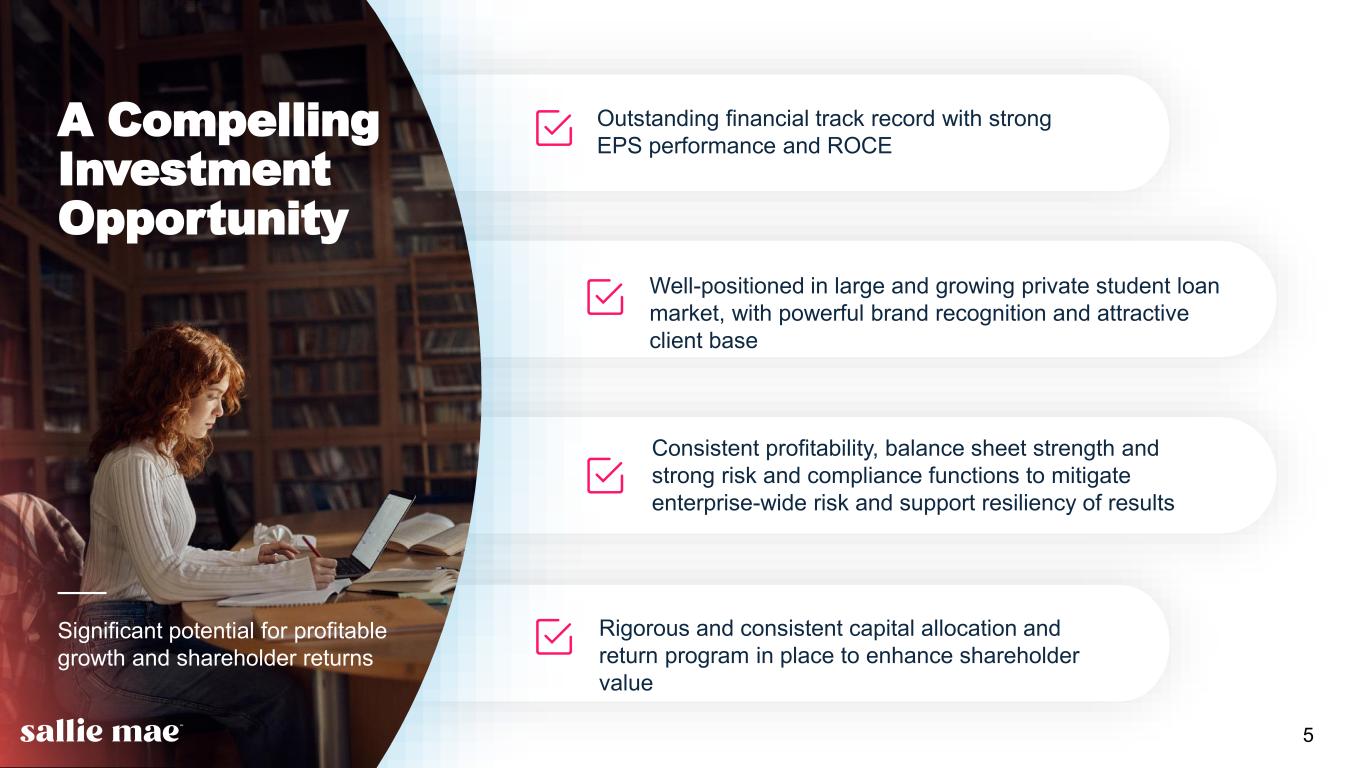
5 Outstanding financial track record with strong EPS performance and ROCE Well-positioned in large and growing private student loan market, with powerful brand recognition and attractive client base Consistent profitability, balance sheet strength and strong risk and compliance functions to mitigate enterprise-wide risk and support resiliency of results Rigorous and consistent capital allocation and return program in place to enhance shareholder value A Compelling Investment Opportunity Significant potential for profitable growth and shareholder returns
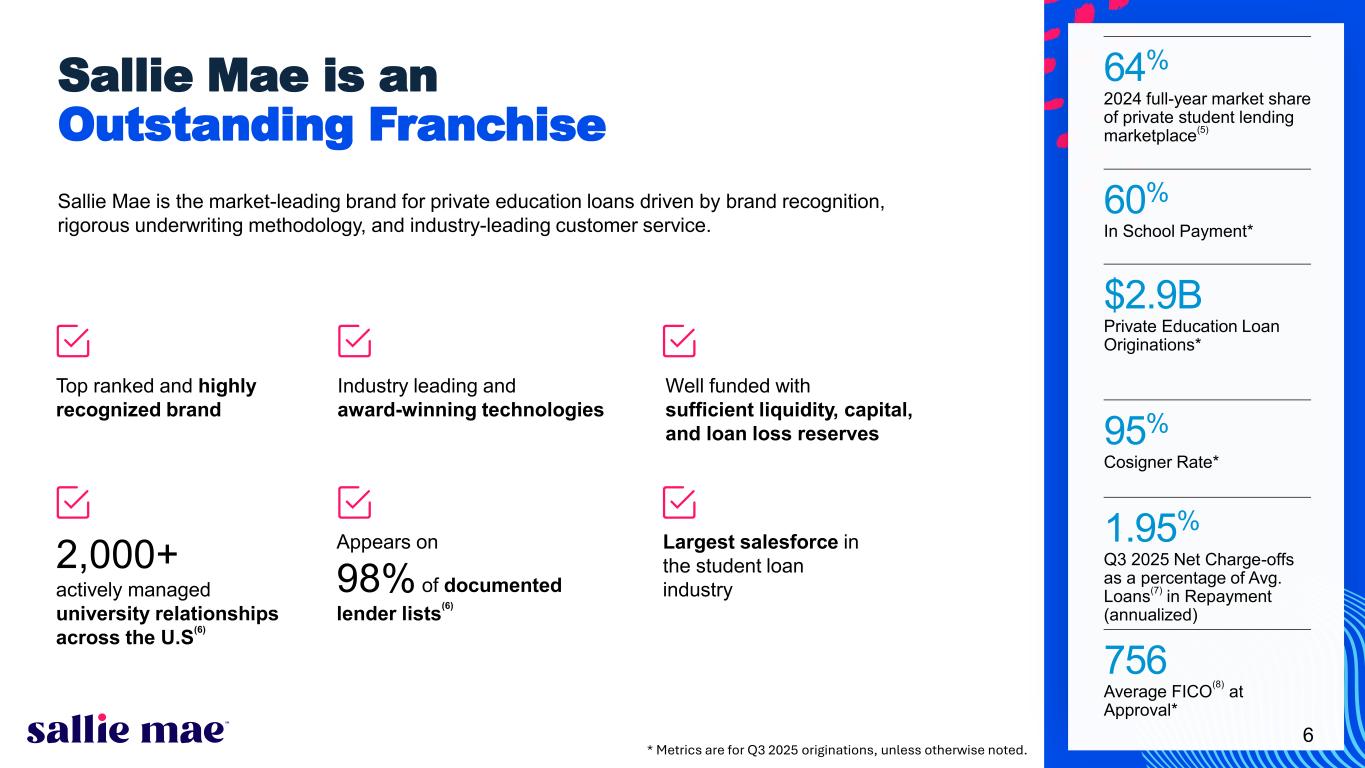
6 64% 2024 full-year market share of private student lending marketplace (5) 60% In School Payment* $2.9B Private Education Loan Originations* 95% Cosigner Rate* 1.95% Q3 2025 Net Charge-offs as a percentage of Avg. Loans (7) in Repayment (annualized) 756 Average FICO (8) at Approval* Top ranked and highly recognized brand Industry leading and award-winning technologies Well funded with sufficient liquidity, capital, and loan loss reserves Sallie Mae is the market-leading brand for private education loans driven by brand recognition, rigorous underwriting methodology, and industry-leading customer service. 2,000+ actively managed university relationships across the U.S (6) Appears on 98% of documented lender lists (6) Largest salesforce in the student loan industry Sallie Mae is an Outstanding Franchise * Metrics are for Q3 2025 originations, unless otherwise noted.
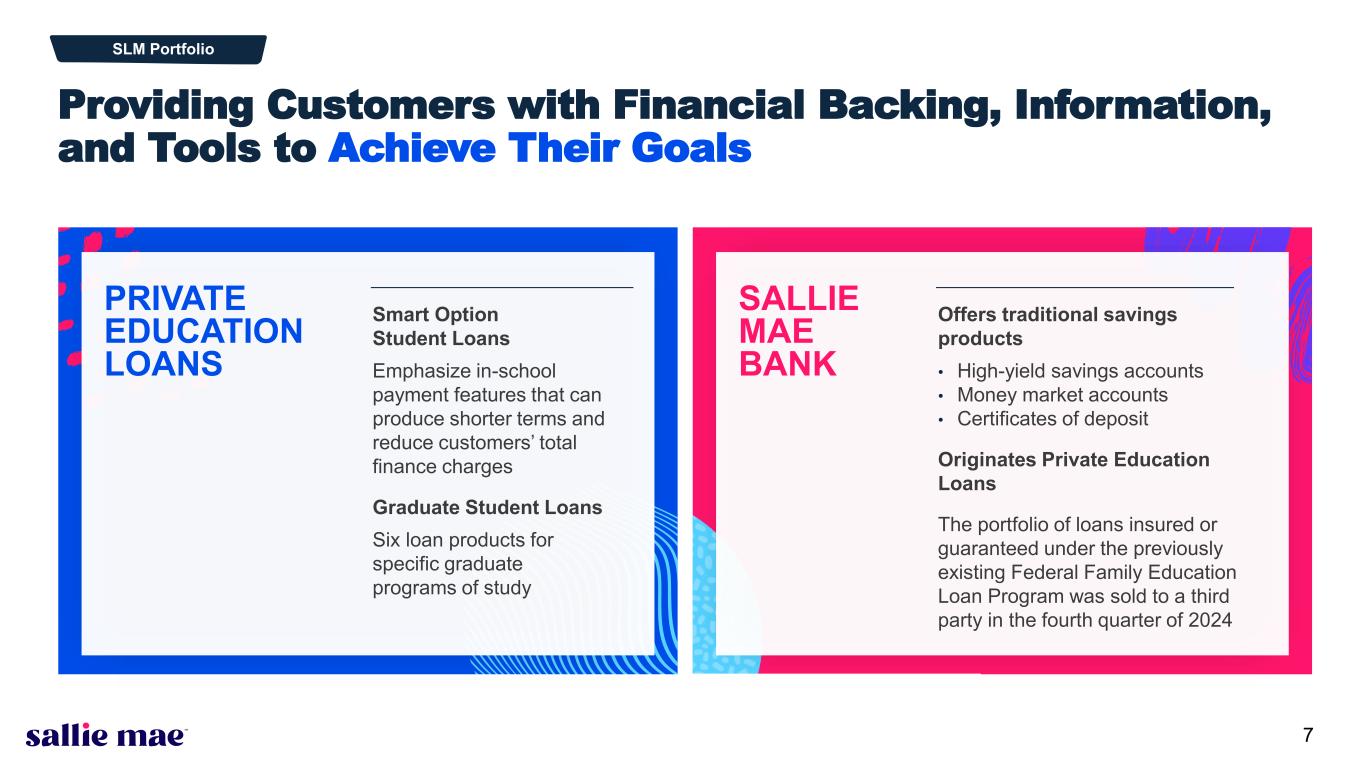
7 Providing Customers with Financial Backing, Information, and Tools to Achieve Their Goals SALLIE MAE BANK Offers traditional savings products • High-yield savings accounts • Money market accounts • Certificates of deposit Originates Private Education Loans The portfolio of loans insured or guaranteed under the previously existing Federal Family Education Loan Program was sold to a third party in the fourth quarter of 2024 PRIVATE EDUCATION LOANS Smart Option Student Loans Emphasize in-school payment features that can produce shorter terms and reduce customers’ total finance charges Graduate Student Loans Six loan products for specific graduate programs of study SLM Portfolio
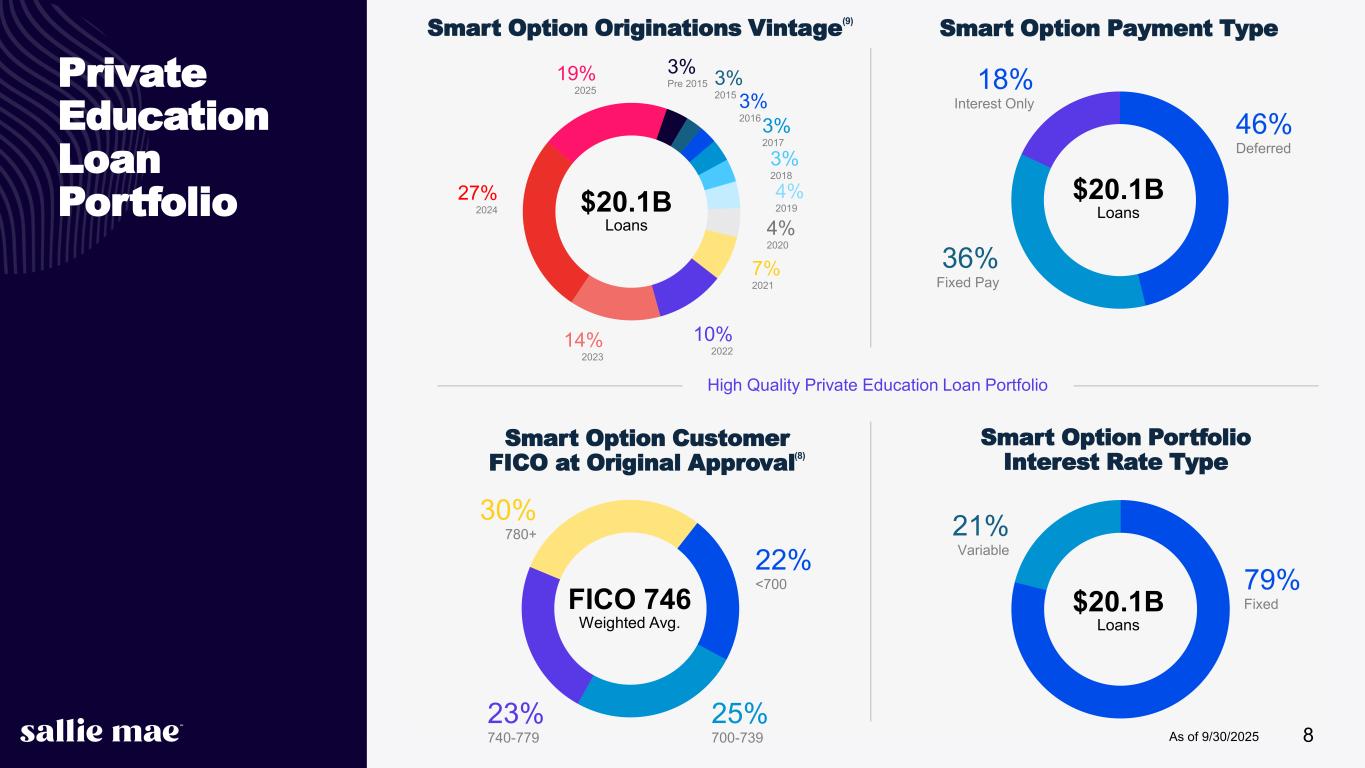
8 Private Education Loan Portfolio High Quality Private Education Loan Portfolio $20.1B Loans 21% Variable 79% Fixed Smart Option Portfolio Interest Rate Type 46% Deferred 36% Fixed Pay 18% Interest Only $20.1B Loans Smart Option Customer FICO at Original Approval (8) 30% 780+ 22% <700 25% 700-739 23% 740-779 FICO 746 Weighted Avg. 27% 2024 3% Pre 2015 3% 2015 3% 2016 3% 2017 3% 2018 4% 2019 4% 2020 7% 2021 10% 2022 14% 2023 $20.1B Loans As of 9/30/2025 19% 2025 Smart Option Originations Vintage (9) Smart Option Payment Type

9 Interest Only loans Require full interest payments during in-school, grace, and deferment periods Fixed Pay loans Require $25 fixed payments during in-school, grace, and deferment periods Deferred loans Do not require payments during in-school and grace periods The Smart Option Loan product, introduced in 2009, consists of: Sallie Mae’s Smart Option Loan • Smart Option payment option may not be changed after selected at origination • Fixed-rate loans or variable- rate loans • Consumer credit underwriting, with minimum FICO and custom credit score model • Marketed primarily through the school channel and directly to consumers, with all loansA certified by and disbursed directly to schools • Qualified education loans are non- dischargeable in bankruptcy, unless a borrower can prove that repayment of the loan would impose an "undue hardship” A Bar Study, and Residency and Relocation loans are exceptions.
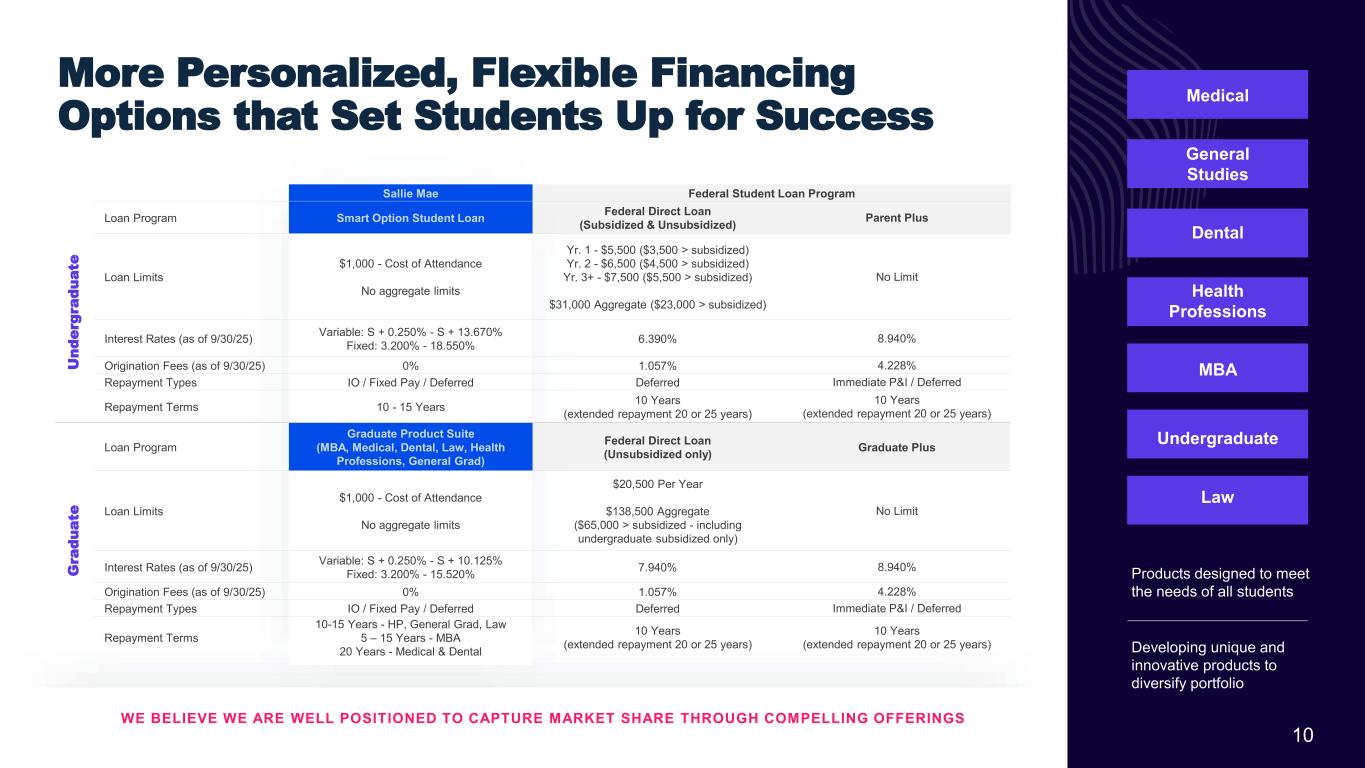
10 More Personalized, Flexible Financing Options that Set Students Up for Success WE BELIEVE WE ARE WELL POSITIONED TO CAPTURE MARKET SHARE THROUGH COMPELLING OFFERINGS Sallie Mae Federal Student Loan Program U n d e rg ra d u a te Loan Program Smart Option Student Loan Federal Direct Loan (Subsidized & Unsubsidized) Parent Plus Loan Limits $1,000 - Cost of Attendance No aggregate limits Yr. 1 - $5,500 ($3,500 > subsidized) Yr. 2 - $6,500 ($4,500 > subsidized) Yr. 3+ - $7,500 ($5,500 > subsidized) $31,000 Aggregate ($23,000 > subsidized) No Limit Interest Rates (as of 9/30/25) Variable: S + 0.250% - S + 13.670% Fixed: 3.200% - 18.550% 6.390% 8.940% Origination Fees (as of 9/30/25) 0% 1.057% 4.228% Repayment Types IO / Fixed Pay / Deferred Deferred Immediate P&I / Deferred Repayment Terms 10 - 15 Years 10 Years (extended repayment 20 or 25 years) 10 Years (extended repayment 20 or 25 years) G ra d u a te Loan Program Graduate Product Suite (MBA, Medical, Dental, Law, Health Professions, General Grad) Federal Direct Loan (Unsubsidized only) Graduate Plus Loan Limits $1,000 - Cost of Attendance No aggregate limits $20,500 Per Year $138,500 Aggregate ($65,000 > subsidized - including undergraduate subsidized only) No Limit Interest Rates (as of 9/30/25) Variable: S + 0.250% - S + 10.125% Fixed: 3.200% - 15.520% 7.940% 8.940% Origination Fees (as of 9/30/25) 0% 1.057% 4.228% Repayment Types IO / Fixed Pay / Deferred Deferred Immediate P&I / Deferred Repayment Terms 10-15 Years - HP, General Grad, Law 5 – 15 Years - MBA 20 Years - Medical & Dental 10 Years (extended repayment 20 or 25 years) 10 Years (extended repayment 20 or 25 years) Products designed to meet the needs of all students Developing unique and innovative products to diversify portfolio Medical General Studies Dental Health Professions MBA Undergraduate Law
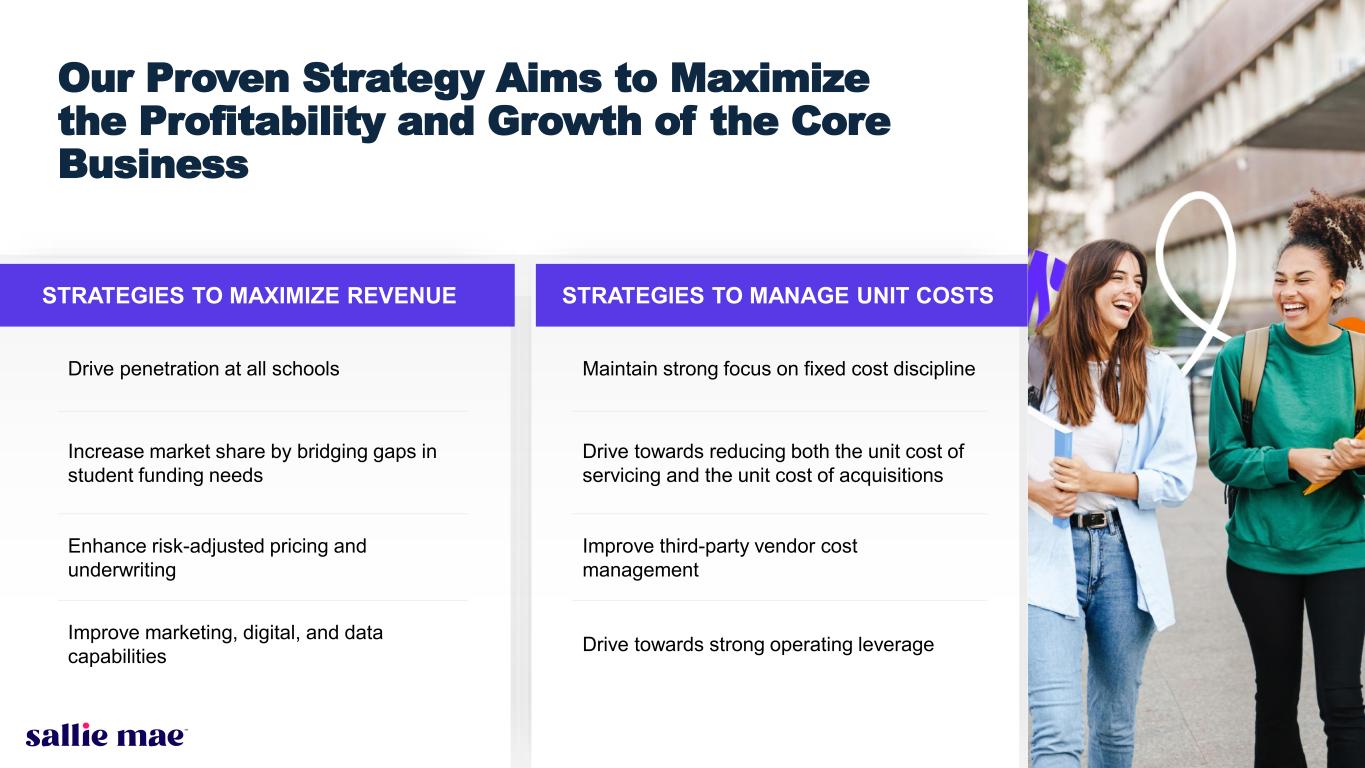
11 STRATEGIES TO MAXIMIZE REVENUE STRATEGIES TO MANAGE UNIT COSTS Our Proven Strategy Aims to Maximize the Profitability and Growth of the Core Business Drive penetration at all schools Increase market share by bridging gaps in student funding needs Enhance risk-adjusted pricing and underwriting Improve marketing, digital, and data capabilities Maintain strong focus on fixed cost discipline Drive towards reducing both the unit cost of servicing and the unit cost of acquisitions Improve third-party vendor cost management Drive towards strong operating leverage

12 v Optimize the Value of the Brand and Attractive Client Base We know our customers’ finances, payment patterns, and indebtedness. We have relationships and knowledge to assist our customers with their next step: post-graduation plans, jobs, and future financial needs. We are there for our customers during and after their important transition to adulthood. Ensure products and services are consistent with our core mission and drive customer value Build products and services that leverage our customer affiliation Prioritize partnerships and other capital efficient avenues of growth Look for opportunities to optimize ROI WHAT WE DO
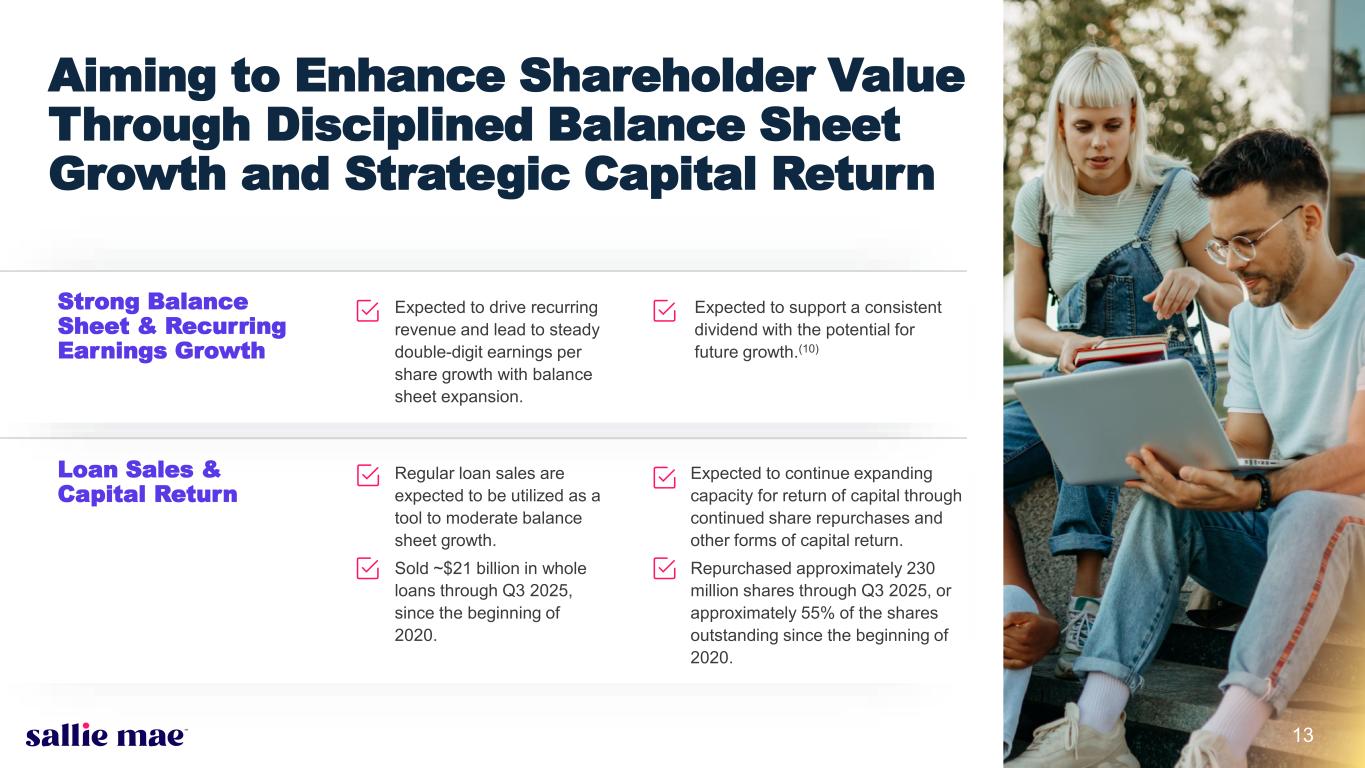
13 Strong Balance Sheet & Recurring Earnings Growth Loan Sales & Capital Return Aiming to Enhance Shareholder Value Through Disciplined Balance Sheet Growth and Strategic Capital Return Expected to drive recurring revenue and lead to steady double-digit earnings per share growth with balance sheet expansion. Expected to support a consistent dividend with the potential for future growth.(10) Regular loan sales are expected to be utilized as a tool to moderate balance sheet growth. Sold ~$21 billion in whole loans through Q3 2025, since the beginning of 2020. Expected to continue expanding capacity for return of capital through continued share repurchases and other forms of capital return. Repurchased approximately 230 million shares through Q3 2025, or approximately 55% of the shares outstanding since the beginning of 2020.

14 Consumers Increasingly Rely on Borrowed Funds to Finance the Cost of a Higher Education Roughly Half of Families Student borrowing is more prevalent than parent borrowing. Borrowing rates vary by school type USED BORROWED FUNDS IN AY 2024-25 SOURCE: How America Pays for College 2025 Families’ out-of-pocket contributions covered half of college costs $236B Family Contribution $160B Grants $11B Other $13B Private Education Loans Higher Education Spend (11) (Academic Year 2023-2024 estimated) $86B Federal & State Loans $506B Total 54% only the student borrowed 32% only the parent borrowed 14% both borrowed 54% of 4-year private school families borrowed 49% of 4-year public school families borrowed 35% of 2-year school families borrowed of costs covered by families’ out-of-pocket contributions of costs covered by scholarships and grants of costs covered by borrowed funds of costs covered by relatives and friends 48% 27% 23% 2%
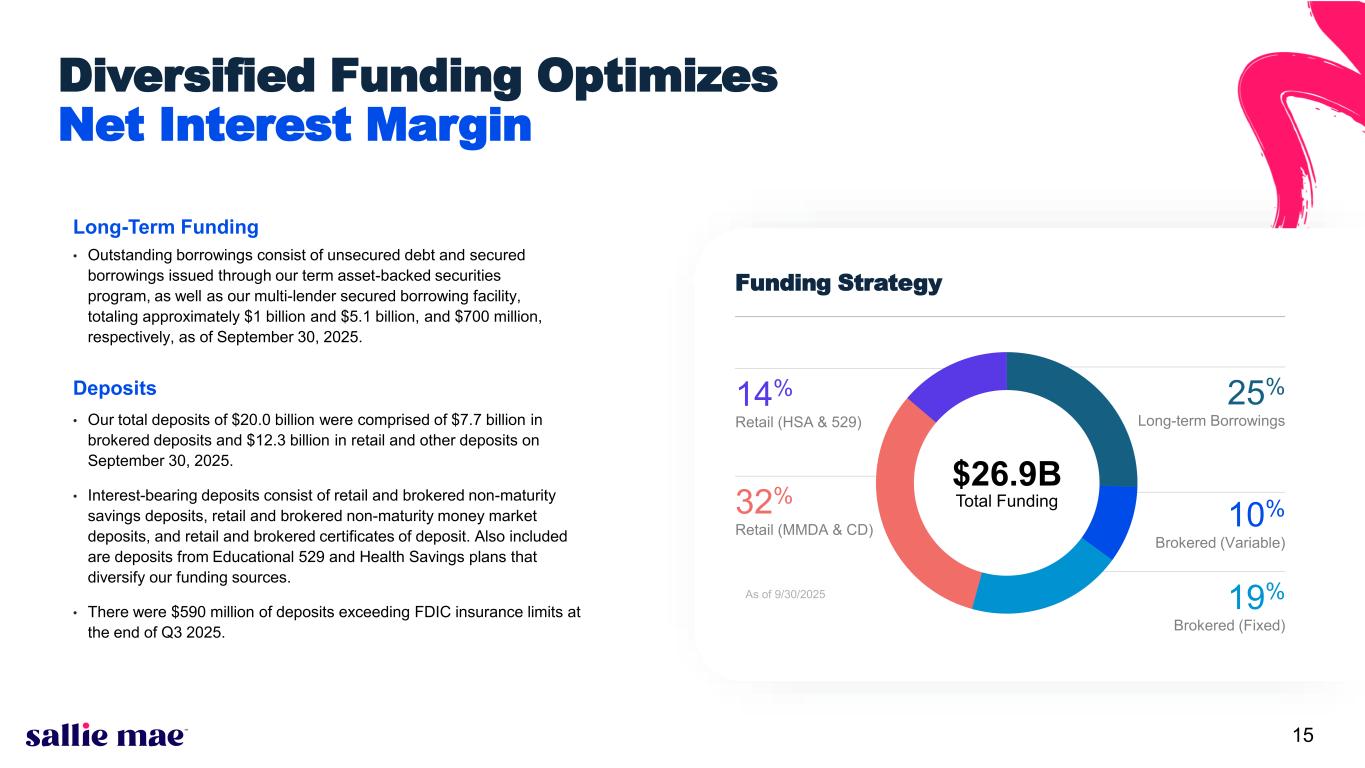
15 As of 9/30/2025 Funding Strategy 25% Long-term Borrowings 19% Brokered (Fixed) 14% Retail (HSA & 529) 32% Retail (MMDA & CD) 10% Brokered (Variable) • Our total deposits of $20.0 billion were comprised of $7.7 billion in brokered deposits and $12.3 billion in retail and other deposits on September 30, 2025. • Interest-bearing deposits consist of retail and brokered non-maturity savings deposits, retail and brokered non-maturity money market deposits, and retail and brokered certificates of deposit. Also included are deposits from Educational 529 and Health Savings plans that diversify our funding sources. • There were $590 million of deposits exceeding FDIC insurance limits at the end of Q3 2025. Diversified Funding Optimizes Net Interest Margin $26.9B Total Funding Long-Term Funding • Outstanding borrowings consist of unsecured debt and secured borrowings issued through our term asset-backed securities program, as well as our multi-lender secured borrowing facility, totaling approximately $1 billion and $5.1 billion, and $700 million, respectively, as of September 30, 2025. Deposits
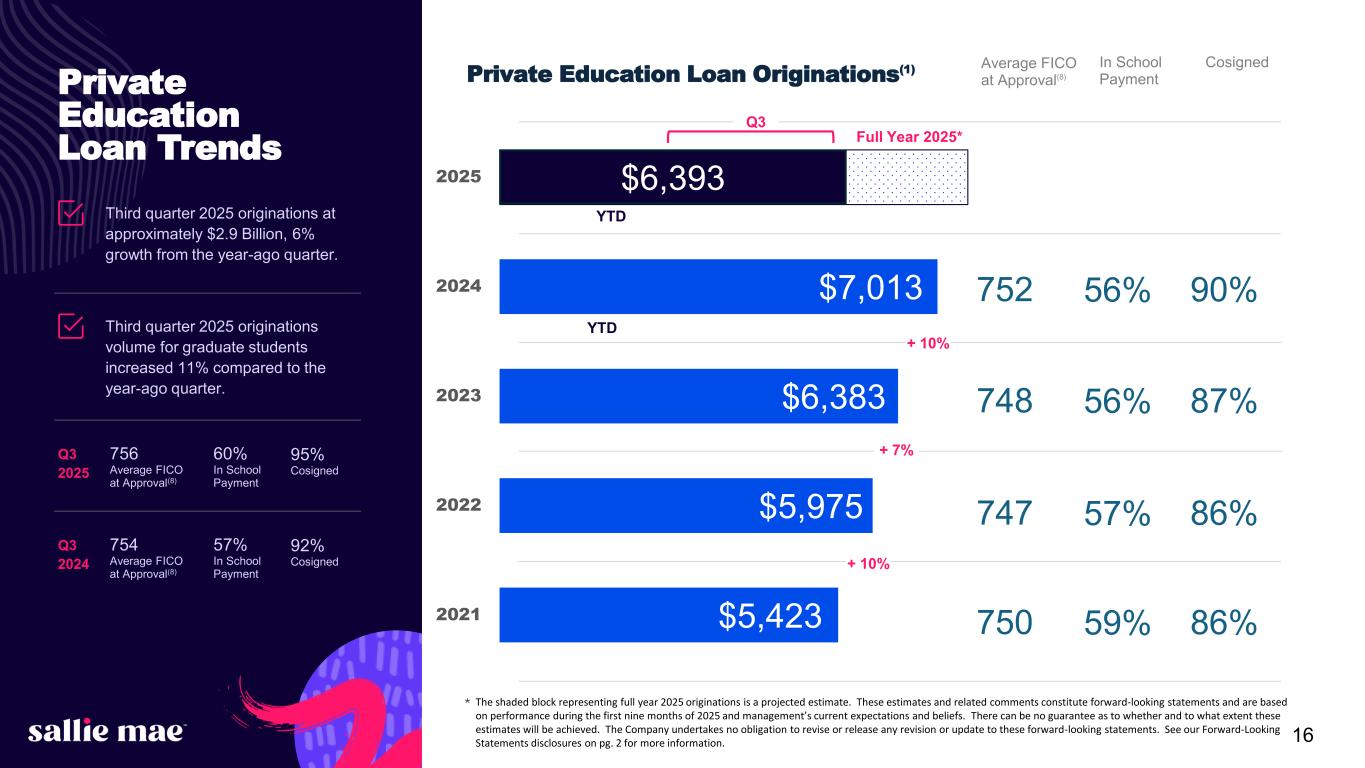
16 Confidential and proprietary information. © 2025 Sallie Mae Bank. All rights reserved. $5,423 $5,975 $6,383 $7,013 2021 2022 2023 2024 2025 87%748 56% 86%747 57% 86%750 59% Private Education Loan Trends Third quarter 2025 originations at approximately $2.9 Billion, 6% growth from the year-ago quarter. Third quarter 2025 originations volume for graduate students increased 11% compared to the year-ago quarter. Average FICO at Approval(8) In School Payment Cosigned Private Education Loan Originations(1) + 7% + 10% 756 Average FICO at Approval(8) 60% In School Payment 95% Cosigned Q3 2025 754 Average FICO at Approval(8) 57% In School Payment 92% Cosigned Q3 2024 + 10% * $6,393 YTD Full Year 2025* YTD 90%752 56% * The shaded block representing full year 2025 originations is a projected estimate. These estimates and related comments constitute forward-looking statements and are based on performance during the first nine months of 2025 and management’s current expectations and beliefs. There can be no guarantee as to whether and to what extent these estimates will be achieved. The Company undertakes no obligation to revise or release any revision or update to these forward-looking statements. See our Forward-Looking Statements disclosures on pg. 2 for more information. Q3

17 ABS Supplement
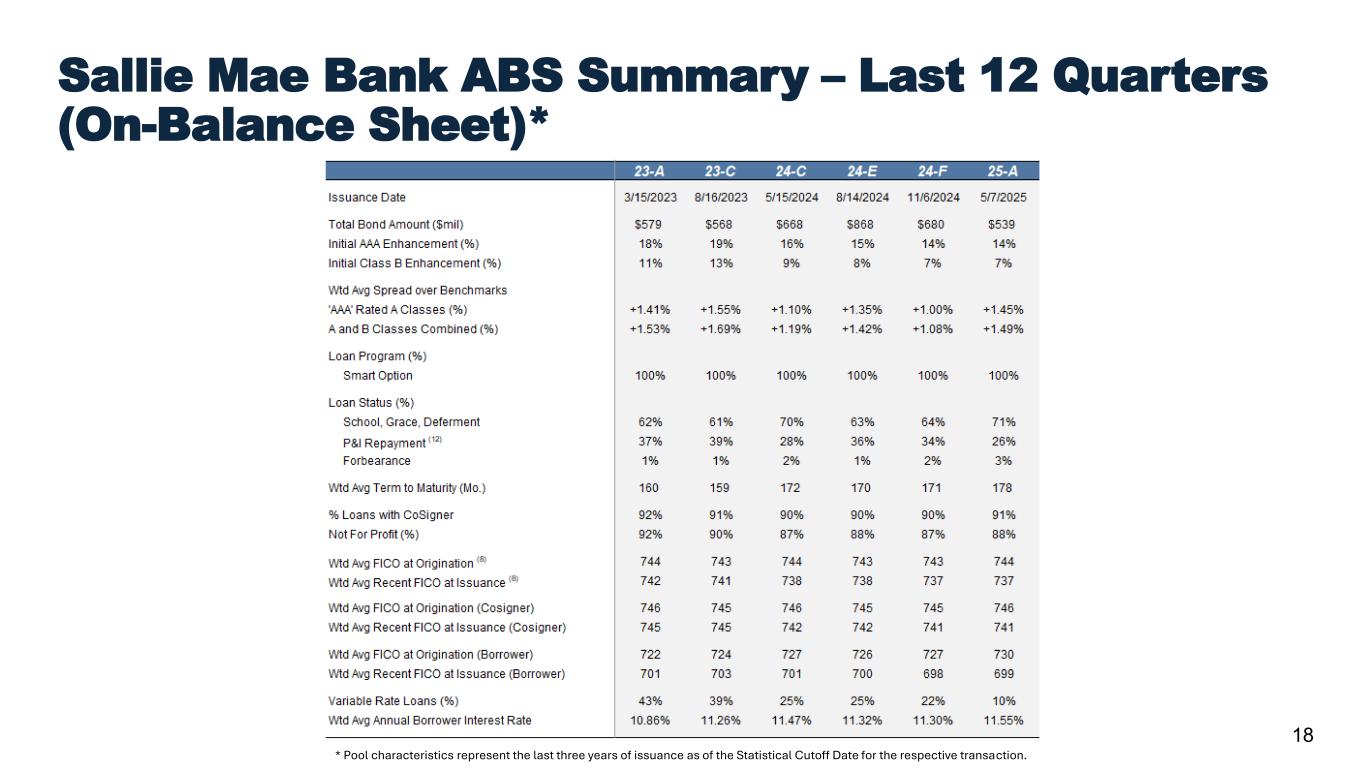
18 Sallie Mae Bank ABS Summary – Last 12 Quarters (On-Balance Sheet)* * Pool characteristics represent the last three years of issuance as of the Statistical Cutoff Date for the respective transaction.
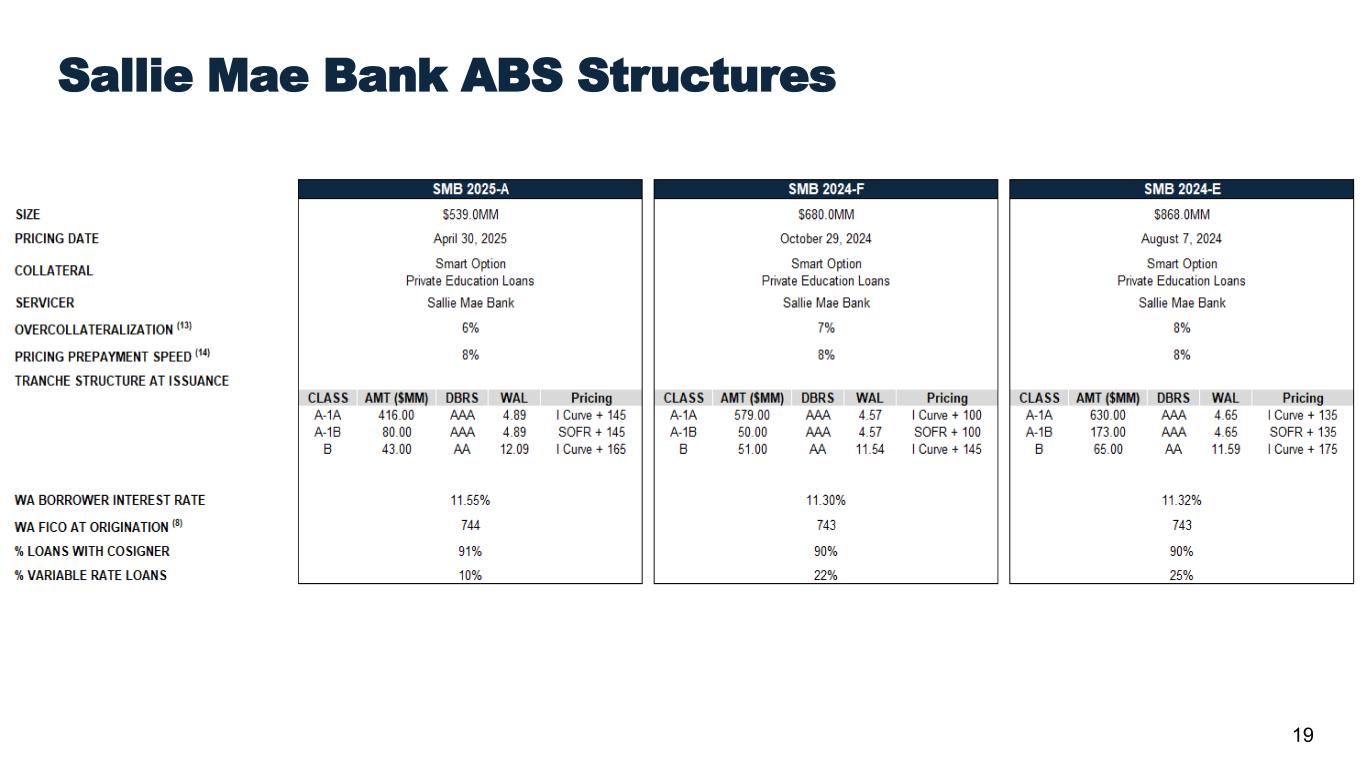
19 Sallie Mae Bank ABS Structures

20 Appendix

21 Confidential and proprietary information. © 2025 Sallie Mae Bank. All rights reserved. Q3 2025 Q2 2025 Q3 2024 Income Statement ($ Millions) $ $ $ Total interest income 658 657 653 Total interest expense 285 280 293 Net Interest Income 373 377 359 Less: provisions for credit losses 179 149 271 Total non-interest income 173 27 24 Total non-interest expenses 180 167 172 Income tax expense (benefit) 50 16 (14) Net Income (loss) 136 71 (45) Preferred stock dividends 4 4 5 Net income (loss) attributable to common stock 132 67 (50) Ending Balances ($ Millions) Private Education Loans held for investment, net 21,615 21,160 20,460 FFELP Loans held for investment, net - - 486 Deposits 20,012 20,482 21,445 Brokered 7,738 8,592 9,844 Retail and other 12,274 11,890 11,601 Q3 2025 Q2 2025 Q3 2024 Key Performance Metrics ($ in millions) Net Interest Margin 5.18% 5.31% 5.00% Yield—Total Interest-earning assets 9.14% 9.25% 9.07% Private Education Loans 10.58% 10.62% 10.79% Cost of Funds 4.24% 4.22% 4.35% Return on Assets (“ROA”)(15) 1.9% 1.0% (0.6%)% Return on Common Equity (“ROCE”)(2) 24.3% 12.6% (10.2)% Private Education Loan Sales $1,936 $- $- Per Common Share GAAP diluted earnings (loss) per common share $0.63 $0.32 $(0.23) Average common and common equivalent shares outstanding (millions) 211 213 215 Quarterly Financial Highlights

22 Confidential and proprietary information. © 2025 Sallie Mae Bank. All rights reserved. Credit Performance (16)(17)(18) Private Education Loans Held for Investment * Total Allowance % of Private Education Loan Exposure defined as total allowance for credit losses as a percentage of the ending total loan balance plus unfunded loan commitments and total accrued interest receivable on Private Education Loans, where total allowance for credit losses represents the sum of the allowance for Private Education Loans and the allowance for unfunded loan commitments. ($ Thousands) Balance % Balance % Balance % Loans in repayment and percentage of each status: Loans current 15,638,904$ 96.0% 15,661,996$ 96.5% 14,806,983$ 96.4% Loans delinquent 30-59 days 335,312$ 2.0% 300,116$ 1.8% 285,471$ 1.8% Loans delinquent 60-89 days 173,135$ 1.1% 143,633$ 0.9% 149,098$ 1.0% Loans 90 days or greater past due 145,119$ 0.9% 125,449$ 0.8% 118,703$ 0.8% Total private education loans in repayment 16,292,470$ 100.0% 16,231,194$ 100.0% 15,360,255$ 100.0% Delinquencies as % of loans in repayment 4.0% 3.5% 3.6% Loans in forbearance 331,761$ 303,704$ 301,414$ Percentage of loans in forbearance: Percentage of loans in an extended grace period(3) 1.0% 0.9% 0.9% Percentage of loans in hardship and other forbearances (4) 1.0% 0.9% 1.0% 5.93% 5.95% 5.84% Net charge-offs as a % of average loans in repayment (annualized) 1.95% 2.36% 2.08% Total Allowance % of Private Education Loan Exposure* SEPT 30, 2024 Quarters Ended SEPT 30, 2025 JUN 30, 2025

23 Confidential and proprietary information. © 2025 Sallie Mae Bank. All rights reserved. Factors affecting the Provision for Credit Losses 3rd Quarter 2025 Allowance for Credit Losses Consolidated Statements of Income – Provision for Credit Losses Reconciliation • Total Allowance % of Private Education Loan Exposure was stable at 5.93%, slightly down from Q2 2025. • The provision decrease from Q3 2024 was largely due to the $119M release of provision from the loan sale and slightly offset by the increase in loan commitments in the third quarter. Quarter Ended September 30, 2025 ($ THOUSANDS) Private Education Loan provision for credit losses: Provision for loan losses 24,704$ Provision for unfunded loan commitments 154,758 Provisions for credit losses reported in consolidated statements of income 179,462$ Confidential and proprietary information. © 2025 Sallie Mae Bank. All rights reserved.
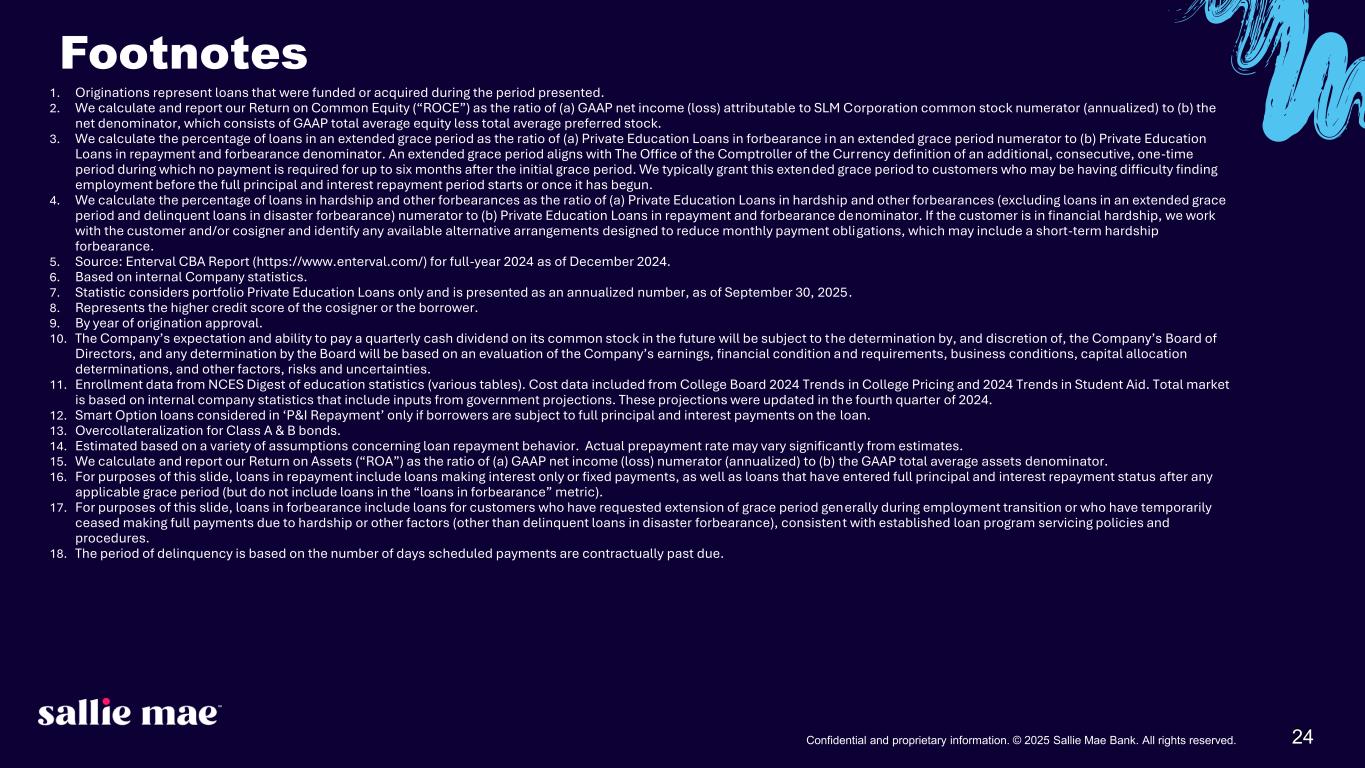
24Confidential and proprietary information. © 2025 Sallie Mae Bank. All rights reserved. 1. Originations represent loans that were funded or acquired during the period presented. 2. We calculate and report our Return on Common Equity (“ROCE”) as the ratio of (a) GAAP net income (loss) attributable to SLM Corporation common stock numerator (annualized) to (b) the net denominator, which consists of GAAP total average equity less total average preferred stock. 3. We calculate the percentage of loans in an extended grace period as the ratio of (a) Private Education Loans in forbearance in an extended grace period numerator to (b) Private Education Loans in repayment and forbearance denominator. An extended grace period aligns with The Office of the Comptroller of the Currency definition of an additional, consecutive, one-time period during which no payment is required for up to six months after the initial grace period. We typically grant this extended grace period to customers who may be having difficulty finding employment before the full principal and interest repayment period starts or once it has begun. 4. We calculate the percentage of loans in hardship and other forbearances as the ratio of (a) Private Education Loans in hardship and other forbearances (excluding loans in an extended grace period and delinquent loans in disaster forbearance) numerator to (b) Private Education Loans in repayment and forbearance denominator. If the customer is in financial hardship, we work with the customer and/or cosigner and identify any available alternative arrangements designed to reduce monthly payment obligations, which may include a short-term hardship forbearance. 5. Source: Enterval CBA Report (https://www.enterval.com/) for full-year 2024 as of December 2024. 6. Based on internal Company statistics. 7. Statistic considers portfolio Private Education Loans only and is presented as an annualized number, as of September 30, 2025. 8. Represents the higher credit score of the cosigner or the borrower. 9. By year of origination approval. 10. The Company’s expectation and ability to pay a quarterly cash dividend on its common stock in the future will be subject to the determination by, and discretion of, the Company’s Board of Directors, and any determination by the Board will be based on an evaluation of the Company’s earnings, financial condition and requirements, business conditions, capital allocation determinations, and other factors, risks and uncertainties. 11. Enrollment data from NCES Digest of education statistics (various tables). Cost data included from College Board 2024 Trends in College Pricing and 2024 Trends in Student Aid. Total market is based on internal company statistics that include inputs from government projections. These projections were updated in the fourth quarter of 2024. 12. Smart Option loans considered in ‘P&I Repayment’ only if borrowers are subject to full principal and interest payments on the loan. 13. Overcollateralization for Class A & B bonds. 14. Estimated based on a variety of assumptions concerning loan repayment behavior. Actual prepayment rate may vary significantly from estimates. 15. We calculate and report our Return on Assets (“ROA”) as the ratio of (a) GAAP net income (loss) numerator (annualized) to (b) the GAAP total average assets denominator. 16. For purposes of this slide, loans in repayment include loans making interest only or fixed payments, as well as loans that have entered full principal and interest repayment status after any applicable grace period (but do not include loans in the “loans in forbearance” metric). 17. For purposes of this slide, loans in forbearance include loans for customers who have requested extension of grace period generally during employment transition or who have temporarily ceased making full payments due to hardship or other factors (other than delinquent loans in disaster forbearance), consistent with established loan program servicing policies and procedures. 18. The period of delinquency is based on the number of days scheduled payments are contractually past due. Footnotes